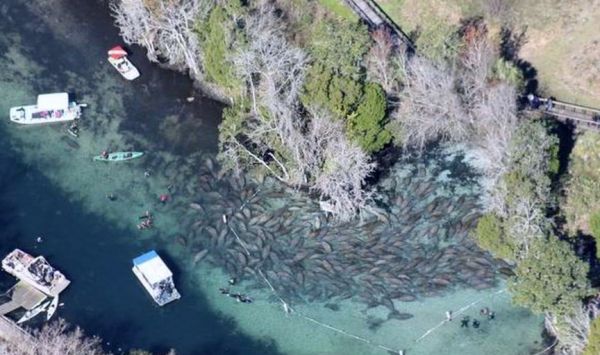“DO MANATEES MERIT DOWNLISTING? I STATED THAT I THOUGHT SO A FEW YEARS AGO. NOW I THINK IT MAY BE PREMATURE."
Dr. John Reynolds, Mote Marine Laboratory
UPDATED (Jan. 7) | The good news is 6,063 Florida manatees were counted in February. And the bad news is 6,063 manatees were counted in February. On Thursday the U.S. Fish and Wildlife Service announced plans to reclassify Florida's iconic sea cow from endangered to threatened, intensifying a controversial debate about federal protections.
In a press conference at the Miami Seaquarium, the agency said the move will not affect conservation measures that are credited with the manatee's recovery. Others aren't so sure.
 “Do manatees merit downlisting? I stated that I thought so a few years ago," said Dr. John Reynolds, a senior scientist at Mote Marine Laboratory in Sarasota and an international authority on marine mammals. "Now I think it may be premature.”
“Do manatees merit downlisting? I stated that I thought so a few years ago," said Dr. John Reynolds, a senior scientist at Mote Marine Laboratory in Sarasota and an international authority on marine mammals. "Now I think it may be premature.”
Reynolds' comments came in March after an annual statewide aerial survey indicated a robust manatee population. The survey by the state Fish and Wildlife Conservation Commission was hailed as a victory for strict state and federal conservation measures. But the FWS has been under legal pressure to take action on a petition by boating and development interests since 2012.
“Rather than reacting only to the [FWC] numbers, I think improved assessments of demography and health would be useful before making a decision to downlist,” Reynolds said.
Reynolds was chairman of the U.S. Marine Mammal Commission from 1991-2010. The commission is an independent federal agency that provides oversight for all U.S. policies, research and management for marine mammals.
Manatees were listed as endangered in 1967 and helped christen the Endangered Species Act in 1973.
"Even though counts are higher, if the quality of individuals is compromised in terms of health or reproduction, then long-term trends could take a quick downturn."
Downlisters say the count, an all-time high, shows the manatee population is strong. Conservationists fear the numbers might be used to weaken the protections they say are responsible for the promising count.

John Reynolds of Mote Marine Laboratory. (Via Mote)
Reynolds heads the International Consortium for Marine Conservation at Mote, a global initiative by scientists that identifies threats of extinction in marine species worldwide. He talked about the status of Florida's manatees in an email in March:
DAILY FRAY: Is the manatee ready to be downlisted to threatened?
“The question you raise is, of course, controversial right now. Let me offer a couple of thoughts:
“A ‘listed’ species is included under the provisions of the [Endangered Species] Act, whether it is classified as endangered or threatened. In the case of marine mammals such as the manatee, the provisions of the U.S. Marine Mammal Protection Act (MMPA) also apply. I bring this information up because an endangered species for which status has improved, like the manatee, should still enjoy the protections of the ESA and MMPA that led to that improvement.
“To address your statement that downlisting is ‘everyone's goal,’ I am not sure that is the case. There are some people who have argued in the past that the number of manatees has grown to the point where they believe that the manatee should be removed from the ESA lists altogether, i.e., be de-listed. Note that if that were to happen, manatees would still be accorded protection under the MMPA.
“Do manatees merit downlisting? I stated that I thought so a few years ago. Now I think it may be premature. My reasons are as follows:
“Even though manatee numbers are higher than we have counted in the past, we should not downlist until we are assured that we understand threats to the persistence of a listed species and have those threats under control. In the case of the manatee, I think that several recent die-offs -- for one of which [Indian River Lagoon] we still have not diagnosed a cause -- and habitat degradation of critical habitats for manatees mean that we do not understand threats or have them under control. Add issues such as effects of climate change, changes in some spring discharges (on which manatees are dependent for warmth in winter) and some other factors that could affect persistence of manatees, and it may be clear why I am reluctant to downlist at this time.
“Although numbers of manatees are higher than in the recent past, manatees occupy waters containing toxins, toxicants and pharmaceuticals that can affect immune function, reproduction, and other factors that can compromise sustainability in mammals and other taxa. We do not know the extent to which that is happening for manatees; even though scientists have the capacity to address questions of sub-lethal effects of stressors on species, there are finite limits to available funding and other questions/issues have taken precedence.
“Thus, even though counts are higher, if the quality of individuals is compromised in terms of health or reproduction, then long-term trends could take a quick downturn. Once again, rather than reacting only to the numbers, I think improved assessments of demography and health would be useful before making a decision to downlist.
“As a final point, I think that the citizens of Florida should feel very good about the fact that manatee numbers have increased in recent years, coincidental to increases in human numbers in Florida. That is fantastic.
“My own opinion, though, is that manatees and their habitat are not ‘in the clear,’ so I would be conservative about downlisting.”
Also:
» FWS conservation profile for West Indian Manatee
» FWS frequently asked questions
» Pacific Legal Foundation sues FWS
 5=Q&A is a feature that appears periodically in The Daily Fray, spotlighting people, issues, places and things. Comments: Editor@TheDailyFray.com.
5=Q&A is a feature that appears periodically in The Daily Fray, spotlighting people, issues, places and things. Comments: Editor@TheDailyFray.com.
Outside
Bitcoin mining emissions in China will hit 130 million tonnes by 2024 https://t.co/w6He7so8N2 pic.twitter.com/qYUDtBdeRK
— New Scientist (@newscientist) April 9, 2021
The Gunk Report
For the Blue-Green Algal Bloom Weekly Update from the Florida Department of Environmental Protection, tap here. For DEP's Algal Bloom Sampling Map, tap here.
What, me worry?
» "PLAYING WITH SHARKS," which recently premiered at the Sundance Film Festival, documents diving legend Valerie Taylor.